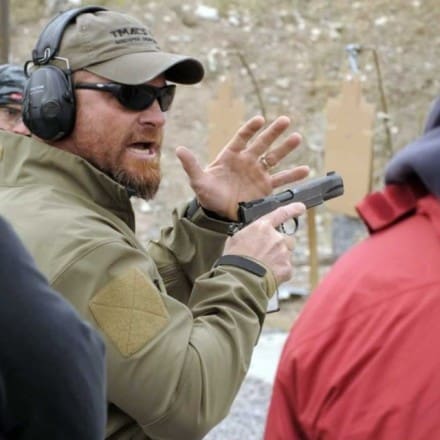I would like to revisit and elaborate on the fact that the best professional performers, regardless of the skill, practice mechanics. They practice these relentlessly and when necessary, in slow motion. They focus on the basics even when these are mundane. They understand that they must have the ability to fail quickly, meaning that they may not dwell on an error. They may not spend any amount of extra time on failing. They have got to get their head back into the game. I was recently asked by a student in my class, what I thought was the biggest problem I encounter with LEOs in training. Thought provoking as LEOs in my classes are typically sharp, have good fundamentals, and are safe gun handlers. The answer I gave him, because it is a recurring theme, is gun handling mechanics under pressure. I’ve got several pressure cooker drills I run in my courses. It is typical to watch shooters fumble with safety manipulation, magazine changes, clearing a stoppage, reloading, building a position around a barricade, and it is also common for the shooter to not understand the status of his weapon. Repetition is not enough to ensure that these mechanics skills are performed intuitively, or with perceptive insight. Pressure must be added to the training event. This is non-negotiable. The ability to compartmentalize the pressure of a gunfight and work mechanics intuitively come from working mechanics correctly and under pressure. The number of repetitions vary between one human being and another. Some say 3,000-5,000 repetitions. Others say 300-500 and there are others who say 33 meaningful repetitions is all that it takes to engrave a new skill into our hard-drives. Not sure which is accurate. Mechanics and fundamentals should be performed with perceptive insight. Performing immediate action or magazine change, safety manipulation, muzzle awareness, establishing a shooting position, acquiring a sight picture, controlling breathing, trigger control, should all be performed at a subconscious level. Forecasting, predicting, planning should be performed consciously.
Patrick McNamara
SGM, US Army (Ret)

Patrick McNamara spent twenty-two years in the United States Army in a myriad of special operations units. When he worked in the premier Special Missions Unit, he became an impeccable marksman, shooting with accurate, lethal results and tactical effectiveness. McNamara has trained tactical applications of shooting to people of all levels of marksmanship, from varsity level soldiers, and police officers who work the streets to civilians with little to no time behind the trigger.
His military experience quickly taught him that there is more to tactical marksmanship than merely squeezing the trigger. Utilizing his years of experience, McNamara developed a training methodology that is safe, effective and combat relevant and encourages a continuous thought process. This methodology teaches how to maintain safety at all times and choose targets that force accountability, as well as provides courses covering several categories, including individual, collective, on line and standards.
While serving as his Unit’s Marksmanship NCO, he developed his own marksmanship club with NRA, CMP, and USPSA affiliations. Mac ran monthly IPSC matches and ran semi annual military marksmanship championships to encourage marksmanship fundamentals and competitiveness throughout the Army.
He retired from the Army’s premier hostage rescue unit as a Sergeant Major and is the author of T.A.P.S. (Tactical Application of Practical Shooting).
Gunfighter Moment is a weekly feature brought to you by Alias Training & Security Services. Each week Alias brings us a different Trainer and in turn they offer some words of wisdom.
Tags: Alias Training and Security Services, Pat McNamara, TMACS Inc



Slow is smooth, smooth is fast. Or, as Wyatt Earp was purported to have said (something like), “In a gun fight, fast is fine, but accuracy is final. Learn to be slow in a hurry.”
On a related noted: AE Welchman, et al., “The Quick and the Dead: When Reaction Beats Intention,” Proceedings of the Royal Society: Biological Sciences 277(2010): 1667–1674* (“Here we develop a behavioural paradigm to test movement dynamics for intentional versus reaction movements and provide evidence for a ‘reactive advantage’ in movement execution, whereby the same action is executed faster in reaction to an opponent.” In short, win or lose, the gunslinger who draws second moves faster.)
* http://rspb.royalsocietypublishing.org/content/277/1688/1667.full.pdf
Amen. And this is EXACTLY why competitive shooting is a worthwhile endeavor for for anyone who carries for work/defense. Having to shoot cold for time and accuracy on a course of fire you saw minutes ago or maybe have not seen at all while a bunch of people you don’t know stand and watch will put you under pressure. It’s not about tactics, but it’s all about learning to be comfortable with being uncomfortable, all while shooting as fast and accurately as the situation dictates.
“Having to shoot cold for time and accuracy on a course of fire you saw minutes ago or maybe have not seen at all while a bunch of people you don’t know stand and watch will put you under pressure.”
That’s indeed a heavily researched area. See, e.g., “Reality-based practice under pressure improves handgun shooting performance of police officers,” “Performing under pressure: Gaze control, decision making and shooting performance of elite and rookie Police officers,” “Reality-based practice under pressure improves handgun shooting performance of police officers”*…. And, more generally, there’s “Perception, Cognition, and Decision Training: The Quiet Eye in Action” by Joan Vickers, “Choke” by Sian Beilock, “With Winning in Mind” By Lanny Bassham, and “A Shot At History: My Obsessive Journey To Olympic Gold” by Abhinav Bindra.
*Sure, guys say they want realism during confined space entry training, so you oblige, toss in a couple of (perfectly friendly) “surprise” Rottweilers, mayhem ensues, and everyone gets pissy.
I would love to train with this dude. I always hear good things about his courses.
As a multiple M.I.S.S. grad ’96-’98; I think auto-mechanics sink in about 500 reps. Betcha Pat busted some caps there @ some point.
P.S. fast is fast.